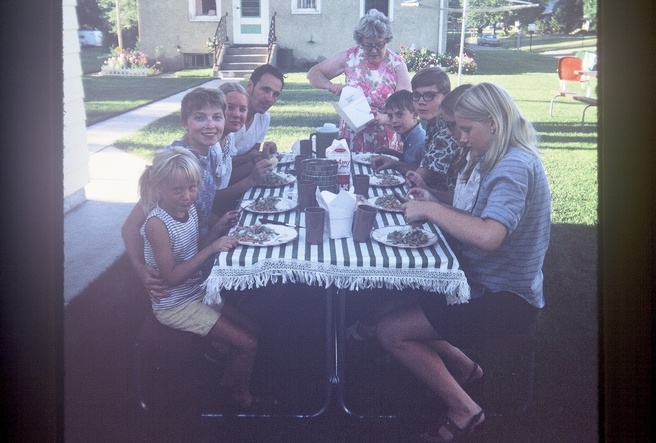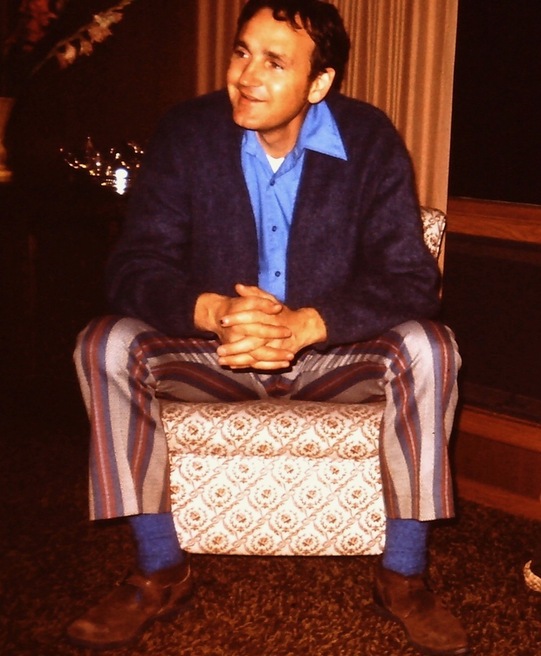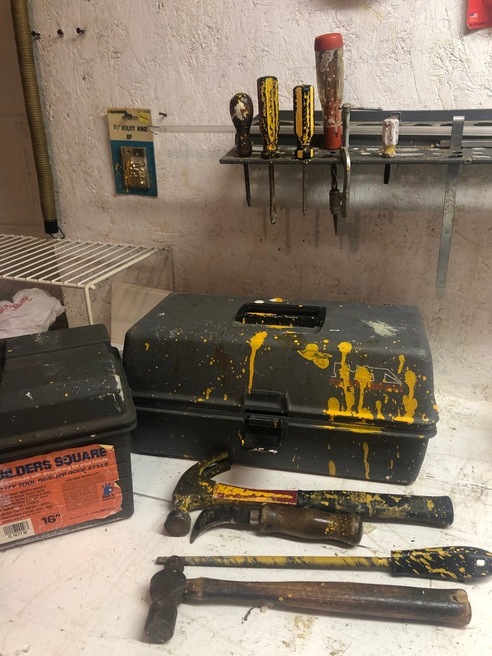(Excerpt from
Fitzpatrick family history, compiled by Mark Fitzpatrick in 2007)
Keen on vehicles of all kinds, Tom went through a series of boats, cars, tractors, vans, campers and motor homes, trading one for another every couple of years.He built a fiberglass canoe at a local do-it-yourself course, and kept it for many years until the canoe was run over by a badly steered tractor. A motorcycle didn’t last long -- Rena strongly disapproved.Tom’s hobbies were wide-ranging.He once bought a heifer, which he kept at a friend’s farm. One time he raised bees, but had to give it up because of allergic reactions to their stings.
They gave us more than money can buy:
A happy home and dreams to the sky.
Ethics and standards, hunger for learning;
To reach for the top, they instilled a yearning.
Tom was also a romantic.He could woo Rena with poetry and entertain any party with his rhyming treasure hunt clues. A fervent Democrat, he instilled in his offspring a sense of justice and compassion for the underdog. And he often talked of adventures. He would take us all off to Alaska to hunt gold; to Africa to join the Peace Corps; to Australia to emigrate. But it was only talk -- or so I thought. In 1968, when he said he would take us all to Mexico for a year, I did not believe it until we actually packed out.
Looking back, the Mexico expedition was a brave venture. Taking a sabbatical leave on half of his meager teacher’s salary, Tom and Rena put their six kids in a used van, attached a pop-up trailer and drove off to spend a year in a new country, language and culture. We spent nine months in San Miguel de Allende, where Tom studied Spanish at Instituto Allende. We kids enrolled in a local Catholic school, Instituto Las Casas where we learned Spanish and took some classes in the vernacular. For housing, we started off in a villa on a bluff at the top of the town, but later moved to a cheaper, more centrally located place where we made do with three small bedrooms, Peggy sleeping on the couch. In the evenings we strolled and flirted in the central square, El Jardin. When Tom’s course of study in San Miguel was finished, we moved for three months to Guadalajara, where he got additional training. A newly started college-level summer school was eager to enroll Rena, Peggy, Mark and Colleen and even Shannon, who was just out of grammar school. The year in Mexico was difficult for Rena, but we all came out the better for it, maybe me most of all. Beforehand, in grant applications to area businesses, Tom explained how the experience would help mold his children. With astonishing foresight, he wrote that one of them might even become a diplomat from the experience.
Turned off by the imperious priests at St. Pious X church, Tom and Rena became central members of the congregation at a new church in nearby Maplewood, Holy Redeemer, headed by Ft. Paul Palmitessa, a longtime family friend who was a childhood friend of Rena’s brother George through seminary school. Our son Tommy was baptized at Holy Redeemer, with Kevin and Patricia Rose as his godparents.
In 1976 Tom received a realtor’s license and in 1979 he opened his own brokerage and formed a syndication to develop and build a townhouse project on the land next to our house, temporarily leaving teaching to do so. It was bad timing, as the housing market went into a depression from 1980 to 1983. It made Tom a graduate of the school of hard knocks. Meanwhile, he also began a series of wise investments in rental properties in the Twin Cities, although managing and maintaining the low-rent units took a toll on his time and patience.The largest property was a seven-unit apartment building on University Ave. SE, Minneapolis, near the University of Minnesota. Colleen, Shannon and Patty Rose all lived there for a time while they attended the university, in exchange for acting as managers. Tom added three new apartments in the basement and took Kyoko and me on as co-owners to help us build an investment portfolio of our own.
In Spanish classes, he taught grammar tense;
As parents, Dad and Mom imparted sense
Of right and wrong instilled in our gut,
So none of us became a right-wing nut.
Tom taught Spanish and English at the junior high and high school levels until he retired in 1990. Hearing about a nice community in Winter Have, Florida, where several of his fellow retired White Bear Lake teachers had property, Tom and Rena set up winter camp there themselves, first with a motor home then buying a mobile home in 1994 and living there about half the year. In 1993, they sold 1818 Elm and eventually moved to a condominium in White Bear Lake Township, within ten minutes drive from the northern suburbs where Kevin’s family lives.
In 2001, Kevin’s office was the venue for a 50th wedding anniversary party for Tom and Rena.Celebrating with them were six children and their spouses, 17 grandchildren, and a host of relatives and old friends. Shannon presented a slide show with old family photos set to music, and Colleen topped all the gifts with an art quilt featuring our family’s cultural history. The themes of our family life over the years included mail order catalogues, cucumbers, strawberries, pumpkins, pets, piñatas, trips, camping, canoes, Florida, and funny Christmas trees. Tom and Rena felt like millionaires.
Inheritance is not just wealth.
Good genes, sound sense, and lifelong health,
Philosophy, the love to read:
What they passed on is rich indeed.




